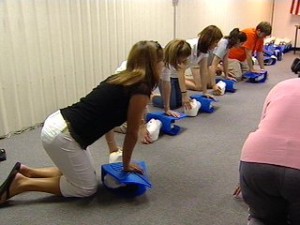Advanced cardiopulmonary resuscitation
In cases of cardiac arrest where the heart stops beating, CPR is used to manually pump blood the rest of the body. CPR uses chest compressions to pump the heart and rescue breaths to give oxygen to the blood. CPR can also restore spontaneous beating of the heart when compressions and breaths are being given. These two basic skills are part of Basic Life Support or BLS. If the heart starts beating but is in arrythmia (irregular heart beats), defibrillation is done. AED (defibrillators) send electricity to the heart to return it to a regular rhythm (sinus rhythm). Defibrillation is sometimes considered part of both BLS and ALS.
Advanced Life Support covers last two to three steps of the AHA’s Chain of Survival. The links of the chain are: (1) recognition of arrest, (2) chest compressions and rescue breaths, (3) defibrillation, (4) ALS, and (5) post-cardiac arrest care.
ALS can be used to describe medical support given to the victim to further stabilize his condition after BLS has been performed, or all five links in the Chain of Survival done in a medical or clinical set up. Giving CPR in a non-healthcare environment is confined to the compressions and rescue breaths given to the victim but CPR in a healthcare setting involves many other things. ALS includes diagnostic examinations like ECG reading and medication from a crash cart used during a code.
ACLS – Advanced Cardiac Life Support

ACLS and PALS are the two programs under ALS training. ACLS stands for Advanced Cardiac Life Support (ACLS) and covers the medical management of adult victims of cardiac arrest. The interventions performed under ACLS are focused on returning spontaneous circulation of blood to the body, the same as BLS. However, ACLS expands on the medical support given, with trainees learning airway management, ventilatory support, and treatment of arrythmias.
Management with medications is an important part of ACLS as well, building upon the skills in BLS (compressions and rescue breaths). Using drug therapy along with compressions and ventilatory support have been show to improve the chances of restoring spontaneous circulation of blood in the body. Medication and defibrillation are also used to return sinus rhythm (normal/regular heart rhythm). Continued monitoring and post-cardiac arrest care is included in ACLS training once the victim or patient has been stabilized.
ACLS training programs last two days, with 16 total class hours. Re-certification is also available for this program and lasts 5 to 6 hours.
Credentials and re-certification
We award training credentials – certificates – to students if they have complete attendance a passing grade on the certification exam. The ACLS certification exam is a practical and written test given after the program. Certificates are valid for 24 months and have to be renewed before they expire. Expired certificates can no longer be renewed and we will have to request the trainee to retake the entire training program (instead of just re-certification classes).
Students who want to take ACLS training are required to have a Basic Life Support for Healthcare Providers training certificate. A pre-test also needs to be passed to qualify for ACLS training.
